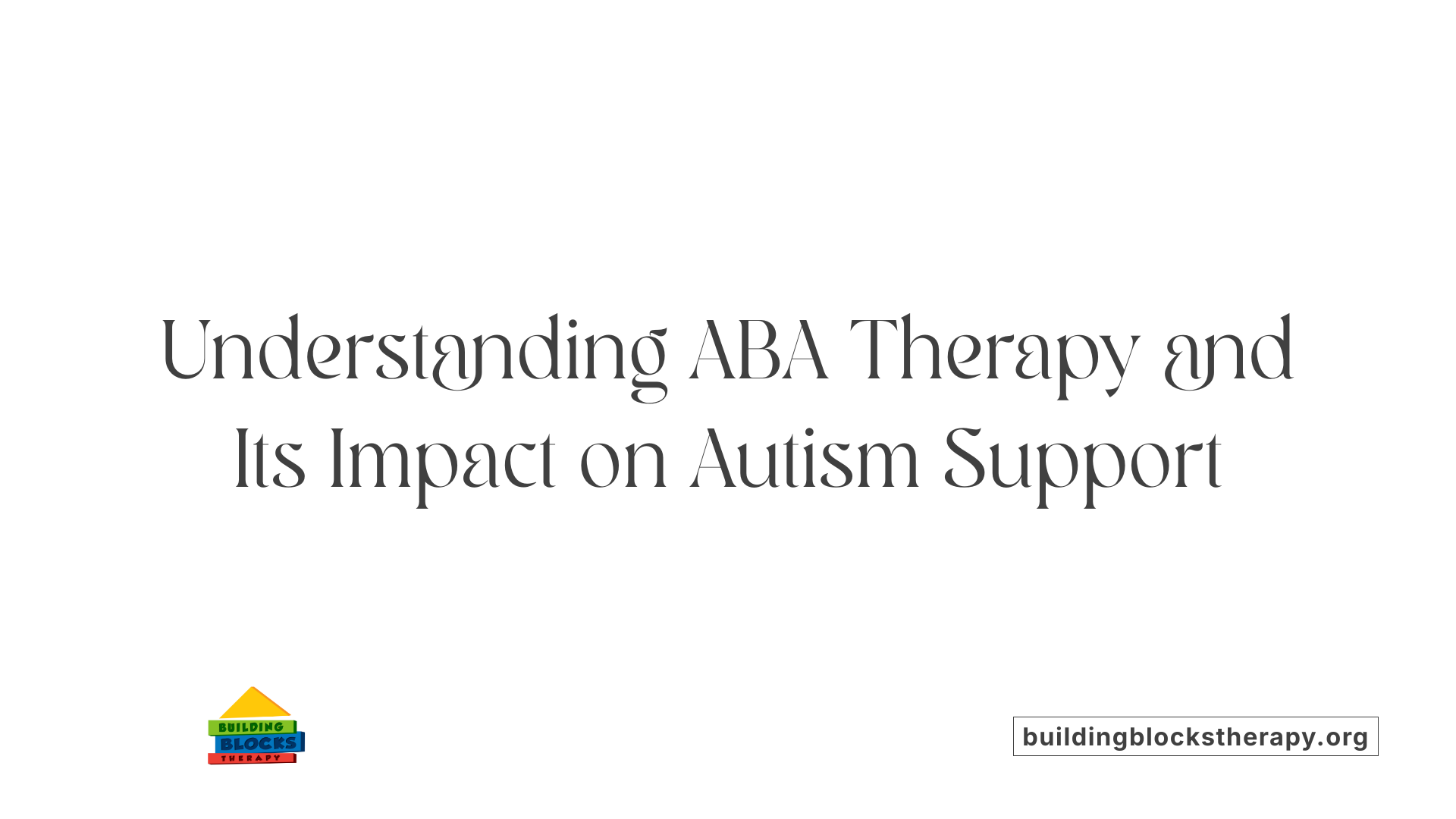Preparing for Puberty with Autism
Navigating the Transition: Supporting Autism Spectrum Youth Through Puberty

Understanding the Intersection of Puberty and Autism
Puberty is a universal developmental milestone, but for children on the autism spectrum, it presents unique challenges that require tailored support. This article explores how puberty impacts youths with autism and how Applied Behavior Analysis (ABA) therapy can play a pivotal role in facilitating this transition smoothly with evidence-based strategies, practical tools, and parent involvement, helping families prepare and empower their children during this critical phase.
What is Applied Behavior Analysis (ABA) Therapy and Its Role in Autism Support?

What is Applied Behavior Analysis (ABA) therapy?
Applied Behavior Analysis (ABA) therapy is an evidence-based approach rooted in the science of learning and behavior. It focuses on increasing helpful behaviors—such as communication, social skills, and self-care—while reducing harmful or disruptive behaviors. ABA uses an understanding of antecedents (what happens before a behavior), the behavior itself, and consequences to shape and modify behaviors effectively.
How does ABA therapy benefit individuals with autism?
ABA therapy benefits people with autism by teaching and reinforcing skills tailored to their unique needs. It systematically helps develop communication, social interaction, and daily living skills. Through techniques like positive reinforcement, ABA encourages helpful behaviors and reduces challenging ones, aiming to improve independence and overall quality of life.
How individualized are ABA programs?
Each ABA program is highly individualized. Programs are designed based on detailed assessments of the person's skills, interests, and family situation. This customization ensures that therapy targets the areas most beneficial to the individual and adapts as they progress.
Who typically provides ABA therapy?
ABA therapy is typically delivered by a team of trained professionals, including Board Certified Behavior Analysts (BCBAs), behavior therapists, and technicians. These experts develop and oversee individualized interventions. Caregivers and family members also play a vital role in reinforcing skills learned during therapy.
How is progress measured in ABA therapy?
Progress is continuously tracked through data collection methods like direct observation and recording the frequency or duration of behaviors. Visual charts and graphs help track improvements over time. Regular assessments and caregiver feedback inform adjustments to the therapy plan, ensuring it remains effective and responsive to the individual's evolving needs.
Understanding Puberty in Children with Autism

What is the typical timeline and what physical changes occur during puberty?
Puberty usually begins around age 12 for girls and age 14 for boys, but it can start as early as 9 or as late as 17–18. Girls experience growth spurts, breast development, pubic and underarm hair growth, vaginal discharge, and menstruation. Boys typically go through growth spurts too, along with increased muscle mass, deepening of the voice, facial and body hair, and development of the penis and testicles.
How does puberty affect brain growth and emotions?
Puberty triggers significant brain growth and changes, which impact cognition, behavior, and emotions. These developments are important for all youth, including those with autism, influencing their decision-making, emotional regulation, and social interactions.
What unique challenges do children with autism face during puberty?
Children with autism experience the same physical changes at puberty but often require tailored support to understand and cope with these changes. Communication difficulties and sensory sensitivities can make physical and emotional changes confusing or overwhelming. Autism-specific strategies include using clear, straightforward language, visual aids, and social stories to demystify the process. Families benefit from preparing children early—around ages 8 to 10—with factual information and supportive routines. This approach helps reduce anxiety and inappropriate behaviors, promoting independence in personal hygiene, understanding boundaries, and managing emotions associated with puberty.
By addressing typical development alongside individualized support methods, caregivers and professionals can ease the challenges of puberty for children with autism, fostering confidence and self-advocacy.
Tailoring Puberty Education and Support for Autistic Youth
Why Start Puberty Discussions Early and Proactively?
Beginning conversations about puberty before physical changes start—typically around ages 8 to 10—provides autistic children with a gradual understanding and better preparation. Early, proactive discussions help normalize the changes they will experience, reducing anxiety and confusion during this critical developmental period.
How Can Clear Language, Visual Aids, and Social Stories Help?
Autistic youth benefit from straightforward, age-appropriate language that is factual and transparent. Visual aids like picture schedules and social stories break down complex concepts into manageable steps, making it easier for children to comprehend new physical and emotional changes. These tools reinforce learning and provide consistent references that children can revisit as needed.
What Should be Taught About Hygiene, Privacy, Boundaries, and Relationships?
Teaching personal hygiene routines using task analysis and reinforcement encourages independence in self-care. Explicit instruction on privacy and physical boundaries helps children understand appropriate touching and social interactions, promoting safety. Discussions about healthy relationships support self-advocacy and social awareness, laying the groundwork for respectful and safe connections with others.
How Do Sensory Modifications and Individualized Preparation Support Autistic Youth?
Since sensory sensitivities can affect responses to puberty-related changes, adapting learning environments and routines is crucial. Tailored strategies might include reducing overwhelming stimuli and providing predictable schedules. Individualized plans respond to each child's developmental level and unique needs, ensuring that the support effectively addresses their emotional and behavioral challenges during puberty.
By combining early, clear communication with personalized teaching methods and sensory accommodations, caregivers and educators can empower autistic children to navigate puberty confidently and safely.
Applying ABA Strategies to Facilitate Puberty Transition
How ABA Uses Visual Schedules and Social Stories for Puberty Education
ABA therapy employs visual schedules and social stories to help children with autism understand the complex changes of puberty. Visual schedules break down the steps of daily routines associated with puberty, making tasks more manageable and predictable. Social stories provide clear, concrete explanations of physical and emotional changes, preparing children for what to expect.
Task Analysis and Reinforcement to Teach Personal Hygiene and Self-Care
Using task analysis, ABA breaks down personal hygiene and self-care routines into smaller, teachable steps. Each step is practiced and reinforced individually, promoting gradual skill acquisition. Positive reinforcement encourages children to complete hygiene tasks independently, boosting their confidence and fostering autonomy.
Teaching Boundaries, Consent, and Safety Through ABA
ABA techniques also focus on teaching children about privacy, boundaries, and consent. Through modeling and reinforcement, children learn to recognize appropriate and inappropriate touching and the importance of personal space. This supports safety and social awareness during puberty's emotional and social challenges.
Using Functional Behavior Assessments (FBAs) to Manage Emotional Outbursts
Functional Behavior Assessments (FBAs) are utilized to identify triggers and reasons behind emotional outbursts related to puberty. Based on this understanding, therapists develop personalized coping strategies and behavioral interventions to reduce distress and improve emotional regulation.
ABA's structured and individualized approach equips children with autism with the skills needed to navigate puberty confidently and safely.
Managing Behavioral Challenges During Puberty With Autism

Aggression and Emotional Outbursts Common in Adolescents With Autism
Adolescents with autism spectrum disorder (ASD) frequently experience increased aggression and emotional outbursts during puberty. These can include self-injury, physical or verbal aggression, and property destruction. Such behaviors often intensify with age and are linked to frustration, irritability, sensory sensitivities, and common comorbid issues like sleep disturbances and gastrointestinal problems.
Risk Factors and Neurobiological Mechanisms of Aggression
Several factors increase the likelihood of aggressive behavior in autistic adolescents. These include male sex, low IQ, childhood aggression, language delays, sensory processing difficulties, and environmental stressors like harsh parenting or low socioeconomic status. Neurobiological contributors involve dysfunctions in brain regions such as the prefrontal cortex and limbic system, as well as altered neurotransmitter pathways involving serotonin, dopamine, and glutamate, influencing impulsivity and emotional regulation.
ABA-Based Strategies for Reducing Aggression and Inappropriate Behaviors
Applied Behavior Analysis (ABA) is a cornerstone in managing aggression and behavioral challenges during puberty for youth with autism. ABA employs functional behavior assessments to identify triggers and consequences of behaviors to tailor interventions. Techniques like positive reinforcement, differential reinforcement of alternative behaviors, functional communication training, and antecedent modification effectively reduce harmful behaviors. Specifically, ABA helps teach personal hygiene, boundaries, consent, and coping skills using visual schedules and social stories designed for the individual’s developmental level.
The Role of Pharmacological Treatments and Multidisciplinary Care
When behavioral interventions alone are insufficient, pharmacological treatments may be considered. FDA-approved medications such as risperidone and aripiprazole are used to address aggression in autism, often alongside adjunctive agents like lithium or clonidine. Optimal care involves a multidisciplinary approach combining ABA therapy, medical oversight, psychological support, sensory integration therapies, and caregiver training. This integrated strategy ensures personalized support, improves quality of life, and minimizes challenging behaviors during the complex transition of puberty.
Parental Involvement and Training in ABA for Puberty Preparation

Importance of Age-Appropriate, Factual, and Open Communication
Parents play a crucial role in preparing children with autism for puberty. Using clear, straightforward, and age-appropriate language helps children understand the physical and emotional changes they will experience. Open communication supports trust and reduces anxiety as children learn about puberty.
Parental Training Modules and Caregiver Involvement in ABA
ABA therapy programs often include specific training modules designed to empower parents. These modules teach caregivers how to discuss puberty topics effectively and how to support their child’s learning at home. Active parental involvement ensures consistency and helps generalize skills learned during therapy sessions to everyday life.
Reinforcing Lessons at Home with Consistent Language and Routines
Consistency is vital when reinforcing puberty-related lessons. Parents are encouraged to use the same terminology and routines introduced in ABA therapy. Regular, supportive conversations and structured schedules help children practice hygiene, boundaries, and consent in familiar environments, promoting independence.
Collaboration with Educators and Medical Providers
Coordinating with teachers and healthcare professionals enriches the support system for the child. Sharing strategies and progress among these stakeholders helps create a unified approach. This collaboration ensures the child receives consistent messages and appropriate adaptations across all settings.
What Should Parents Consider When Choosing an ABA Therapy Provider?
Parents should verify that the ABA provider employs certified and experienced therapists who use individualized, ethical, and evidence-based methods. Providers should involve parents in treatment planning, maintain transparency about progress, and adapt plans as the child grows. It is important to look for supervised programs, positive reinforcement techniques, and avoid providers using punitive methods. Assessing safety, comfort, and data-driven progress monitoring ensures effective, respectful therapy tailored to the child’s needs.
Resources and Tools to Support Families During Puberty Transition

Autism-Specific Puberty Toolkits, Books, and Guides
Families navigating puberty with children on the autism spectrum can benefit significantly from specialized resources tailored to their unique needs. Autism-specific puberty toolkits offer structured guidance and visual supports that make complex changes easier to understand. Books and guides designed for this audience provide straightforward explanations about physical and emotional developments, hygiene, consent, and social boundaries, empowering both children and caregivers.
Digital Tools Including Apps and Checklists
Technology also plays a vital role in supporting puberty education. Various apps and digital checklists help track milestones and daily routines related to hygiene and self-care. These tools often incorporate visual schedules and reminder systems that reinforce learning and independence. By leveraging technology, families can create consistent and engaging ways for children to prepare for and manage puberty.
Collaboration with Educators and Health Professionals
Effective puberty preparation involves a team approach. Collaboration with educators and healthcare providers ensures that children receive consistent messages and support across settings. Professionals can assist in customizing educational content and medical explanations to the child’s developmental level. This integrated support helps normalize the experience and addresses questions as they arise.
Normalization and Empowerment Through Informed Resources
Providing children with accessible and factual information normalizes the changes they undergo during puberty. Empowerment comes from understanding — using informed resources builds confidence and reduces anxiety around bodily and emotional transformations. Encouraging open and age-appropriate conversations supported by these resources fosters self-advocacy and independence in youth with autism throughout the puberty transition.
Embracing a Holistic Approach to Puberty Preparation
Preparing children on the autism spectrum for puberty requires a thoughtful, individualized approach combining the structured methods of ABA therapy with compassionate communication and family involvement. Early preparation using clear language, visual supports, and social stories helps youth understand their changing bodies and emotions. ABA provides effective tools for teaching hygiene, boundaries, and coping skills, while functional behavior assessments and multidisciplinary care address behavioral challenges. Empowering both children and caregivers through training and trustworthy resources ensures a smoother transition during puberty and fosters independence and self-advocacy. With the right support systems, youth with autism can navigate puberty confidently, enhancing their overall quality of life and well-being.





